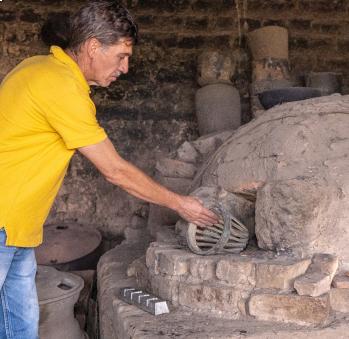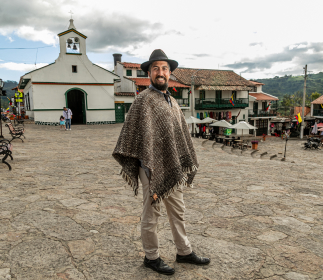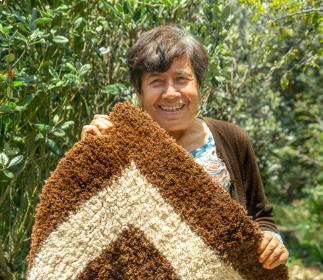Sergio Arturo Tristancho
Workshop: Campanas Sergio Arturo Tristancho
Craft: Forja
Trail: Paipa-Iza and Paipa - Guacamayas Route
Location: Nobsa, Boyacá
“Something happens when you hear him speak: you cannot take your eyes off him. You feel as though you are in the presence of a druid that has the particularity of also being an alchemist. This man, who is barely 50, has more than 200 years of tradition in his blood: that of bell-making. Although it may seem strange to think of this trade as something to dedicate one’s life to, it has been his daily life since he can remember. “You learn to walk in the middle of the foundry and play with the chair that is used to mold and with the dirt, because there is a lot of dirt. You play with your hands at all times, that is how you learn.” Just as you also learn the secrets and the mystique that go with the craft like, for instance, the fact that you should always cast on Fridays due to the positions of the lunar phases.
His family tree is clear: his great-great-grandfather, Eufrasio Tristancho, was the one who started the trade, which was brought over from Spain in colonial times. Suffice it to say that he lived for 102 years to show how far back the story goes. He passed the craft on to Juan José Tristancho, Sergio’s great-grandfather. He, in turn, left this knowledge to both of his sons: Marco Antonio and Luis Felipe. The first one taught it to Hernán, who, according to our protagonist, has been the best master bellmaker so far and who Sergio is trying to surpass. Hernán did not leave any heirs, but his grandfather Luis Felipe did: he fathered Carlos Arturo and Francisco. Sergio is Carlos Arturo’s son. This long chain of male heirs brakes with his own daughters, Adriana Lucía and Alejandra, both of whom know the trade and have the strong will to not let it die.
Crafting a bell can take two months after its commission. It involves making the clay molds one by one —every bell is unique—, mixing the clay with which it will be made with three different types of sand, and kneading it with the feet to achieve the perfect texture. Moreover, the mold is personalized according to what the customer is looking for by making a high relief that will later be transferred to the bell, just like the tradition according to which a child’s birth is recorded by means of a bell with their name on it. Just so we can understand the complexity of this art, Sergio Arturo tells us about the process in six stages: the frame, the internal turn, the definition of thickness and reliefs, the counter mold, and the box. Once all of this is done, the piece is dried, unadjusted, and its thickness is retouched so that it can be baked and melted. At that moment, metals appear: a copper, bronze, and tin alloy that they know by heart and that the bell-maker will submit to a temperature of 1,200 Celsius degrees to melt, a process that can start at the end of the afternoon on a Friday and finish when the night goes to bed. And then, polish it.
Our senior bell-maker places great emphasis on the delivery that every bell gets, where the entire process is done by hand. The dedication to the thicknesses and their polishing will be what will determine their tolling, that is, their sound. That is why no bell will sound like another. It is an act of faith. And, if we are talking about faith, it has not only been the church what has kept this art alive through the years, but also the rituals that come with it: “my grandfather was a very devout Catholic, and he taught us to believe, to bless the oven before casting, to cross ourselves before starting to work. The mystical part is very important in this trade.” And the codes it represents, like its tolling, which have been created by history and reproduced by sacristans, are different whether it is a man or a woman who dies, or whether it is calling for Easter or for the celebration of the holidays.
It is fascinating to hear it, for it shows what bells are and have been to men. And he recounts it: “The first means of communication that could have ever existed was the bell. When it rang, you knew you had to gather around it.
The bell warns of many things. It has prevented tragedies. When a river grows, the bell rings, and people leave their homes because they know something happened. It is a way to warn and summon.” And to call, of course. When the gate of the house is far away, you can also call with a bell. And, as if all of this were not enough, it is said and believed that ringing a bell purifies the environment, that it makes bad energies stay away from a specific place and they are used for sound therapy. Rather, everything is a surprise in the tale of this man generous in knowledge who lives in what is known in Nobsa as “the corner of bells,” in the village of Ucuengá. He also holds the record for having made the largest bell in Latin America: it is 2 meters tall, weighs 1,200 kilograms and today rests in Nobsa. There is only one thing left to say: Long live the bells
“
Craft
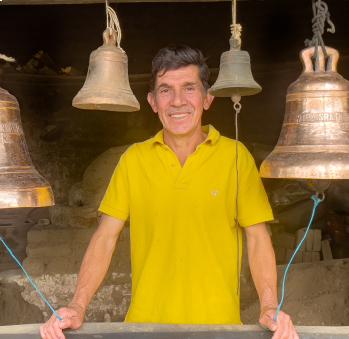


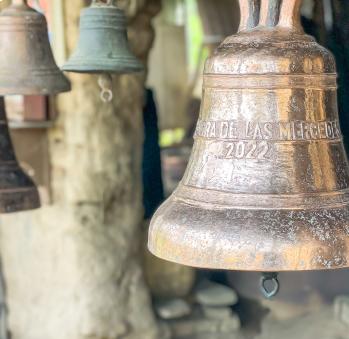






Artisans along the way
Artisans along the way
No puede copiar contenido de esta página










































